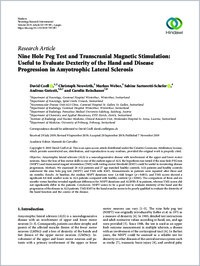Nine hole peg test and transcranial magnetic stimulation: useful to evaluate dexterity of the hand and disease progression in amyotrophic lateral sclerosis
- Czell, David Department of Neurology, Cantonal Hospital Winterthur, Winterthur, Switzerland - Department of Neurology, Spital Linth, Uznach, Switzerland
- Neuwirth, Christoph Neuromoscular Disease Unit/ALS Clinic, Cantonal Hospital St. Gallen, St. Gallen, Switzerland
- Weber, Markus Neuromoscular Disease Unit/ALS Clinic, Cantonal Hospital St. Gallen, St. Gallen, Switzerland
- Sartoretti-Schefer, Sabine Department of Radiology, Cantonal Hospital Winterthur, Winterthur, Switzerland
- Gutzeit, Andreas Department of Radiology, Paracelsus Medical University Salzburg, Salzburg, Austria - Department of Chemistry and Applied Biosciences, ETH Zürich, Zürich, Switzerland - Institute of Radiology and Nuclear Medicine, Clinical Research Unit, Hirslanden Hospital St. Anna, Lucerne, Switzerland
- Reischauer, Carolin Institute of Radiology and Nuclear Medicine, Clinical Research Unit, Hirslanden Hospital St. Anna, Lucerne, Switzerland - Department of Medicine, University of Fribourg, Fribourg, Switzerland
-
07.11.2019
Published in:
- Neurology Research International. - 2019, vol. 2019, p. 1–5
English
Amyotrophic lateral sclerosis (ALS) is a neurodegenerative disease with involvement of the upper and lower motor neurons. Since the loss of fine motor skills is one of the earliest signs of ALS, the hypothesis was tested if the nine hole PEG test (NHPT) and transcranial magnet stimulation (TMS) with resting-motor threshold (RMT) could be useful in monitoring disease progression. Methods. We examined 28 ALS patients and 27 age-matched healthy controls. ALS patients and healthy controls underwent the nine hole peg test (NHPT) and TMS with RMT. Measurements in patients were repeated after three and six months. Results. At baseline, the median NHPT durations were 1,4-fold longer (p < 0.001), and TMS scores showed a significant 0.8-fold smaller score in ALS patients compared with healthy controls (p < 0.001). The comparison of three and six months versus baseline revealed significant differences for NHPT durations and ALSFRS-R in patients, whereas TMS scores did not significantly differ in the patients. Conclusion. NHPT seems to be a good tool to evaluate dexterity of the hand and the progression of the disease in ALS patients. TMS RMT to the hand muscles seems to be poorly qualified to evaluate the dexterity of the hand function and the course of the disease.
- Faculty
- Faculté des sciences et de médecine
- Department
- Médecine 3ème année
- Language
-
- English
- Classification
- Medicine
- License
-
License undefined
- Identifiers
-
- RERO DOC 327721
- DOI 10.1155/2019/7397491
- Persistent URL
- https://folia.unifr.ch/unifr/documents/308514
Statistics
Document views: 133
File downloads:
- pdf: 158
